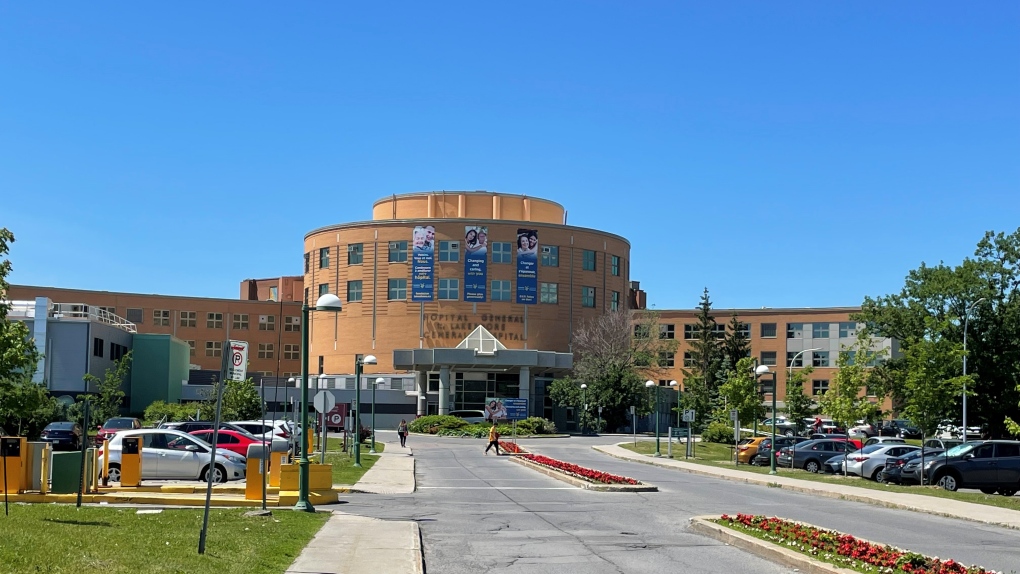AI-assisted oxygenation device shows promise in Quebec hospitals
 Lakeshore Hospital on Montreal's West Island. (Matt Gilmour/CTV News)
Lakeshore Hospital on Montreal's West Island. (Matt Gilmour/CTV News)
A new device assisted by artificial intelligence (AI) used in respiratory therapy is being tested in Quebec hospitals and may eventually be deployed on a wider scale. It automatically adjusts patients' oxygen intake, reducing the risk of under-oxygenation.
Millions of patients receive oxygen every day, whether in hospital or at home. The device, which goes by the name “Free O2,” uses AI to adjust the flow of oxygen every second according to the patient's needs.
This tool was developed at the Institut universitaire de cardiologie et de pneumologie de Québec - Université Laval (IUCPQ). It was approved by Health Canada in 2019.
At the Lakeshore General Hospital in Montreal, testing of the device in the intensive care unit has been promising. The device reduced the average hospital stay for patients from 40 hours to 11 hours.
In intensive care, nurses and respiratory therapists see patients every hour, whereas on other floors this period can be more spaced out. “Despite the increased surveillance, we had a gain in terms of patients seeing their length of stay reduced substantially,” said Kevin McElreavy, head of respiratory activities at Lakeshore General Hospital.
CIUSSS de l'Ouest-de-l'Île-de-Montréal is integrating the “Free O2” machine into other facilities, like the LaSalle Hospital, which got it in January.
The Ministère de la santé et des services sociaux (MSSS) announced that three other sites are piloting the device: CHUM, CISSS Montérégie-Centre and CIUSSS du Saguenay-Lac-Saint-Jean. The goal is to have healthcare establishments show the value of the technology before introducing it on a wider scale, the ministry told The Canadian Press.
Outdated traditional method
“Free O2” aims to replace the ball flow meter, a technology invented over a century ago that requires extensive staff supervision.
“Giving oxygen to our sick patients is something we've been doing for over 100 years, but the way it's done hasn't changed much. It was done manually, oxygenation was connected via a cylinder or piped system directly to the patient with adjustment done by a therapist,” said McElreavy.
Instead of manually adjusting the amount of oxygen given to the patient, the new device continuously measures the patient's oxygen saturation and adjusts it. This limits the risk of complications associated with hypoxemia (low oxygen levels) and hyperoxia (excess oxygen). The number of under-oxygenated patients has fallen from 17.2 per cent to 2.5 per cent, according to CIUSSS de l'Ouest-de-l'Île-de-Montréal tests.
McElreavy said when respiratory distress occurs, staff will mobilize and care for the patient appropriately, avoiding the possibility of death. However, he believes that the distress experienced by the patient when they are unable to breathe properly should not be overlooked.
“If the professional has 30 patients to look after, they can't see them all at once, they have to see them one after the other. Necessarily, between now and 1 a.m., there's a good chance that the patient's oxygenation needs will have changed,” said McElreavy.
Considering that the tests at his hospital were carried out in intensive care, where there is increased supervision by nurses and respiratory therapists, McElreavy believes the benefits of the device have greater potential on emergency or other floors where there is less medical supervision.
This report by The Canadian Press was first published in French on Nov. 9, 2024.
CTVNews.ca Top Stories

opinion Tom Mulcair: Prime Minister Justin Trudeau's train wreck of a final act
In his latest column for CTVNews.ca, former NDP leader and political analyst Tom Mulcair puts a spotlight on the 'spectacular failure' of Prime Minister Justin Trudeau's final act on the political stage.
B.C. mayor gets calls from across Canada about 'crazy' plan to recruit doctors
A British Columbia community's "out-of-the-box" plan to ease its family doctor shortage by hiring physicians as city employees is sparking interest from across Canada, says Colwood Mayor Doug Kobayashi.
'There’s no support': Domestic abuse survivor shares difficulties leaving her relationship
An Edmonton woman who tried to flee an abusive relationship ended up back where she started in part due to a lack of shelter space.
opinion King Charles' Christmas: Who's in and who's out this year?
Christmas 2024 is set to be a Christmas like no other for the Royal Family, says royal commentator Afua Hagan. King Charles III has initiated the most important and significant transformation of royal Christmas celebrations in decades.
Baseball Hall of Famer Rickey Henderson dead at 65, reports say
Rickey Henderson, a Baseball Hall of Famer and Major League Baseball’s all-time stolen bases leader, is dead at 65, according to multiple reports.
Arizona third-grader saves choking friend
An Arizona third-grader is being recognized by his local fire department after saving a friend from choking.
Germans mourn the 5 killed and 200 injured in the apparent attack on a Christmas market
Germans on Saturday mourned the victims of an apparent attack in which authorities say a doctor drove into a busy outdoor Christmas market, killing five people, injuring 200 others and shaking the public’s sense of security at what would otherwise be a time of joy.
Blake Lively accuses 'It Ends With Us' director Justin Baldoni of harassment and smear campaign
Blake Lively has accused her 'It Ends With Us' director and co-star Justin Baldoni of sexual harassment on the set of the movie and a subsequent effort to “destroy' her reputation in a legal complaint.
Oysters distributed in B.C., Alberta, Ontario recalled for norovirus contamination
The Canadian Food Inspection Agency has issued a recall due to possible norovirus contamination of certain oysters distributed in British Columbia, Alberta and Ontario.


































